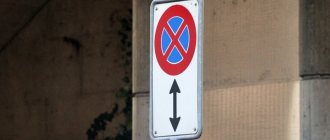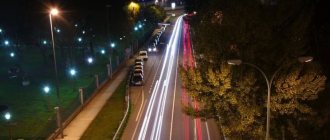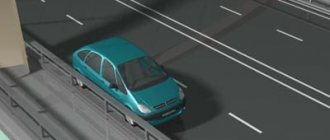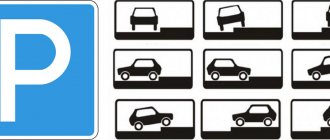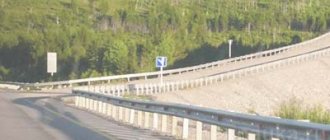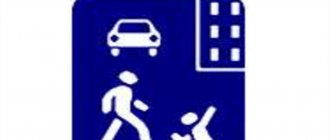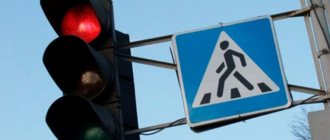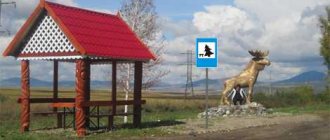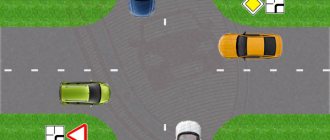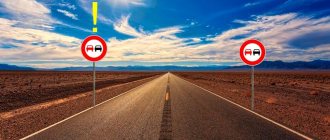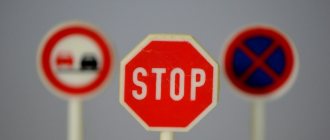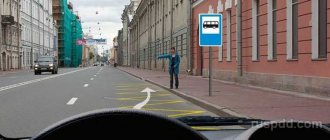Description and history
The road sign has a round shape, a blue background with a red border around the circumference and red stripes intersecting at an angle of 90 degrees - a kind of cross. Thanks to this coloring (valid since 2013), the sign is clearly visible even from afar.
In its familiar form today, this road definition appeared in 1973 after the introduction of the standard on the territory of the Soviet Union. Before this event, the specified road sign was decorated in yellow colors. The rules have been and continue to be regularly amended, but after 2013 they have not yet addressed issues related to this sign. But the size of fines (administrative liability), to the chagrin of those who are not friends with the law, has increased significantly since 2013.
How to interpret a sign with one or two stripes?
While driving, you can see a “no parking” sign containing one or two vertical stripes . Such a sign can be interpreted as follows: parking in the area covered by the sign is prohibited on odd or even days of each month, depending on the number of stripes. You need to remember this if you don't want to get a fine.
Also, some signs may provide for a different order of alternation than the daily one. Then, instead of stripes, the signs will have dates indicating the period of alternation. Let's say from the 1st to the 15th or from the 16th to the 31st, alternating from the 1st to the 16th monthly.
Interpretation of a road sign
Sometimes motorists are annoyed when they see that stopping is prohibited. Nothing is done for nothing, especially in approved traffic rules, including those as amended since 2013. This means that on these sections of the road, a stopped vehicle can become a serious obstacle, creating emergency situations when drivers of other vehicles will be forced to break the rules when passing (for example, in areas with busy traffic, on too narrow roads, if there is a sharp turn ahead).
In places indicated by this sign, not only stopping, but also parking (or parking) of vehicles is prohibited.
In more detail, before or behind the sign it is prohibited:
- a planned stop of a vehicle for a duration longer than that required for exiting or boarding passengers, loading or unloading cargo, and, of course, parking or parking;
- any previously planned stop lasting more than 5 minutes.
In this case, a forced stop or parking is possible if the vehicle breaks down or the driver feels unwell, as well as for other similar reasons. In this case, the driver must turn on the hazard warning lights. You will also need to post an emergency stop sign on the road. If all these conditions are met, traffic police officers will not record a violation.
An exception is also provided for stopping route vehicles. These categories of road users are allowed to stop in places specially designated for them to stop, but not in front of them.
At the same time, there is no provision for imposing a fine for stopping cars driven by disabled people if the sign is supplemented with the appropriate plate (8.18) - a wheelchair is graphically displayed, crossed out with a red line.
Also, the driver should not pay attention to the installed road sign prohibiting stopping if a representative of the traffic police slows him down - this will not constitute a violation. So, he is obliged to stop at the place indicated to him by the traffic policeman or traffic police inspector.
What is the difference between stopping and parking?
Not every road user can say what the concept of stopping and parking means and in what cases the driver is issued a fine. In fact, these are different terms, and you need to clearly understand their meaning so as not to be subject to penalties or to avoid being the culprit of an accident.
To put it in more understandable terms, the difference between these terms is the duration of the process .
- when stopping, transport stops moving for a short time;
- When parked, the vehicle remains stationary for a longer period of time.
If we turn to the rules, a stop is considered a planned braking for up to 5 minutes, and a parking is a vehicle being stationary for a long time, not caused by boarding or disembarking passengers, or unloading or loading luggage.
Zone where the traffic sign is valid
The territory covered by the prohibitory action of the road sign extends to:
- intersection (this does not include a break in the dividing line, exits from courtyards in populated areas, as well as the exit of a small forest or field road);
- the place where the settlement ends (if there is no road intersection before the corresponding designation);
- a road sign has been installed that cancels all previously existing restrictions (3.31).
One more nuance: stopping (parking) is prohibited only on the side of the road where the sign is posted. For example, if on one side of the road (for example, on the right) with a one-way direction of movement, the driver paid attention to the “stopping is prohibited” sign, then this will not prevent him from stopping on its left side in an acceptable place. Parking here is not regarded as a violation and does not entail penalties.
What does a no parking sign look like?
In order to avoid violating the current legislation and a fine, every driver should have an idea of what a “no parking” sign looks like. This is a round indicator with a cross section of about 0.25 m . in places where there are no populated areas, it must have a cross-section of 0.6 m. It must have a blue background, complemented by a red border and inclined stripes.
Consequences of parking near a no parking sign
Keep in mind that if you park in the wrong place, this will lead to certain consequences. And in order to somehow bring some sense into frivolous drivers, the authorities annually increase the amount of fines for non-compliance with these orders. If we look at the Code of Administrative Offenses of 2014, drivers who violate the “parking prohibited” requirement are required to pay a fine of 1,500 rubles. in any locality. In Moscow and St. Petersburg, such an offense involves a fine, the amount of which can reach 3 thousand rubles . However, it all depends on the situation, so in some cases the punishment may simply be the detention of the car.
But you can easily avoid such an unpleasant situation if you know which signs you shouldn’t stop at and what they mean. To do this, you need to carefully study the traffic rules.
Nuances of the sign's action
The coverage area of road signs can be indicated by using signs together with a sign. So, if there is a sign 8.2.3 under the sign (an arrow that goes down), then this means that stopping before it is prohibited. If these signs are violated, a fine will be imposed on the driver who stopped immediately in front of these signs. But at the same time, stopping directly behind the sign is not prohibited and is not regarded by inspectors as a violation of the rules.
If there is a sign 8.2.2 under the sign (an arrow going up and digital symbols below it), then this sign indicates the distance within which stops cannot be made. For example, if a sign has a sign (i.e., an additional message with important information is attached underneath it), which shows an up arrow and the number 50 m, then stopping (parking) is prohibited at the specified interval, starting from the installation site.
At the same time, it is not prohibited to stop directly in front of him - accordingly, a fine will not be imposed.
If there is a sign with a double arrow pointing up and down, then this is a reminder to motorists (if the period where the restrictions apply is long) that the ban is still in effect and you cannot stop. That is, parking is prohibited in the place in front of and behind this sign.
Yellow markings along the curb or along the edge of the road (solid line) - 1.4, this determines the coverage area of the sign installed in front of it. This means that stopping and parking are allowed in front of it or after the end of the marking line. If you do not follow the indicated marks, this is automatically equated to a violation of the rules, which means a fine will follow.
The zone in which, according to the sign, stopping is prohibited, can be interrupted if there is a parking lot in this place, which is indicated by the corresponding sign (the name of the sign “Parking” was introduced in 2013).
Is it permissible to stop under a “no parking” sign?
Now is the time to consider a more democratic “no parking” sign, if you break it you will still have to pay a fine. Not all drivers, especially those with little experience, know that this sign only prohibits parking , and there are no prohibitions on stopping in its area of operation. Therefore, if you decide to stop your car under a sign for no more than 5 minutes, as well as in cases when you want to drop off or pick up a passenger, you can be sure that you have not violated any rules and you will not face a fine. Such a situation can be interpreted as a stop, which is not a prohibitory action established for the sign.
Limit of the ban
In order not to violate the rules of behavior on the road and to avoid a fine, you must also know the boundaries that are covered by the “no parking” sign. It covers the space from the sign installation site to road sections , a list of which is presented below:
- The first intersection that is closest to you;
- Border of a populated area;
- The area where the sign “end of the zone of all restrictions” is installed.
After crossing any of the above sections of the highway, know that you can safely stop the car at any time. However, be careful in those places where there is an exit from areas adjacent to the road, as well as in places where the main route intersects with unpaved roads, provided that there is no priority sign in front of them. Keep in mind that these rules also apply to the sign described, as well as the “stopping and parking prohibited” sign.
When is it permissible to park in a prohibited zone?
The effect of a sign prohibiting parking can be limited by another sign - parking. But keep in mind that this sign must have a sign indicating the distance over which this prohibition applies.
Also, along with a sign prohibiting parking, there may be a marking on the asphalt made as a yellow broken line covering the top of the curbs, sidewalk or roadway. You are required to follow these markings: its completion means that the prohibitory sign is no longer in force in this area, and you can safely stop the vehicle without worrying about being ticketed.
But keep in mind that this prohibitory sign is only valid on the side of the road where it is installed.
Who has the right to stop under a “no stopping” sign?
While driving, you must remember that prohibitory signs do not apply:
for drivers classified as disabled people of groups 1 and 2;- if we are talking about transport intended for transporting such people, if it has the appropriate disabled sign;
- for taxi cars, provided that they have a taximeter included;
- for cars that represent the Federal Postal Service of the Russian Federation;
- on cars that are engaged in servicing organizations and retail outlets, provided that there are no workarounds in the area of the “no stopping” sign.
In case of violation of the stop sign, a fine is only one of the penalties that such an action can lead to. Therefore, in any case, you must be careful when parking.
Where is it prohibited to stop according to traffic rules? Exceptions
A stop prohibited road sign may be accompanied by additional symbols that expand or limit the scope of its action. The following signs may be placed next to this sign:
Rectangular sign with an up arrow on a white background. This means that the prohibition extends forward in the direction of movement of the vehicle and begins from the point where the sign is located.
The need to prohibit stopping vehicles with the installation of signs 3.27 is due to many reasons. Here are some of them:
- To prevent traffic jams. If, during high traffic volumes, one of the traffic lanes is occupied by parked cars for a long time, this can lead to the creation of congestion on city streets.
- To prohibit cars from stopping near government agencies, schools, stadiums, concert halls, etc., as well as high-risk objects.
- To ensure road safety - in areas with limited visibility, when a stationary car can provoke a traffic accident.
Road signs “No stopping” with an arrow down in the indicated cases are installed if necessary, if the ban on stopping needs to be lifted, for example, not at the nearest intersection, but earlier, in a certain place, after which the effect of the main prohibited element loses its force.
This designation, like all other signs, is subject to the following rule: the sign is valid until the nearest intersection or end of a populated area.
An exit from a nearby area cannot be considered an intersection, and therefore does not affect the scope of the sign. The same is true for intersections with country roads or turns that are not taken into account by markings, other signs or other traffic rules.
In addition to knowing how to interpret a road symbol, it is important to have information about the point to which it extends. The law provides three grounds for terminating a no-stop sign:
- Crossroads. In this case, it means the intersection of several roads. Leaving the yard does not apply to intersections.
- Beyond the border of the settlement. The end of a populated area is grounds for termination of the sign.
- The presence of a sign that cancels the effect of all those installed before it.
The stop sign is prohibited and the coverage area extends only to one side of the road, that is, the driver has the right to park his car on the other side, for example, in one-way traffic.
Today, a common option is that on even days of the week you are allowed to stop on one side, and on odd days - on the other. Thus, the coverage area of the stop sign is prohibited by the traffic rules.
